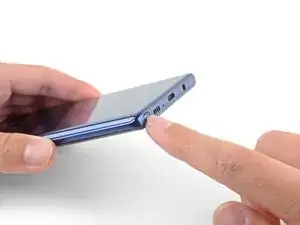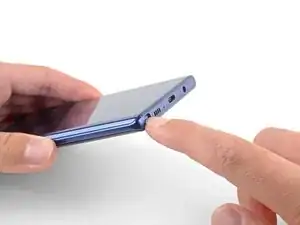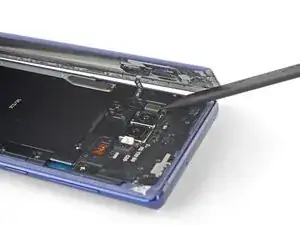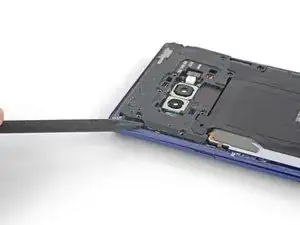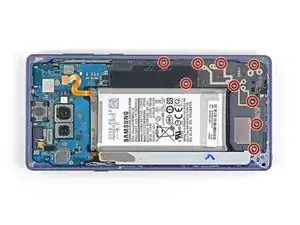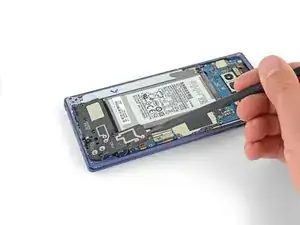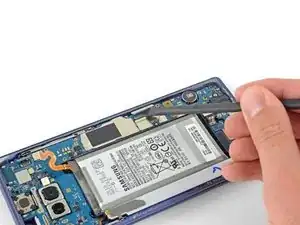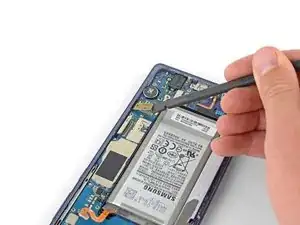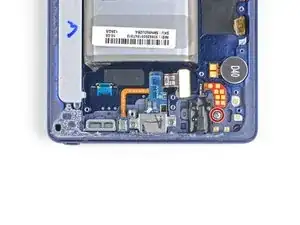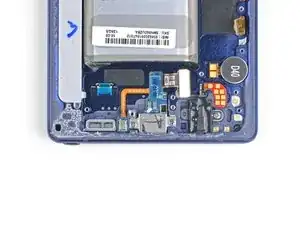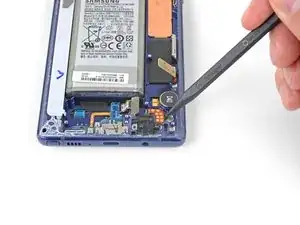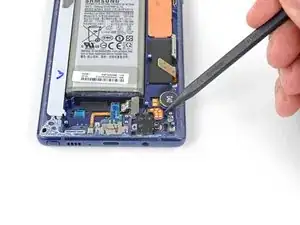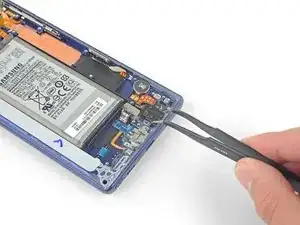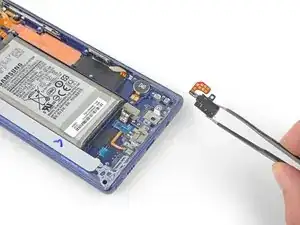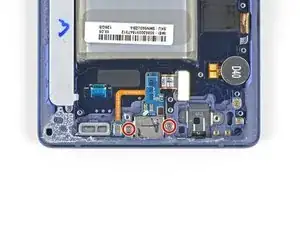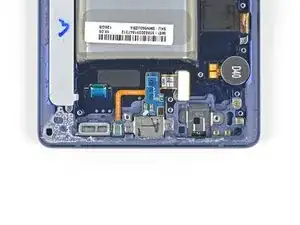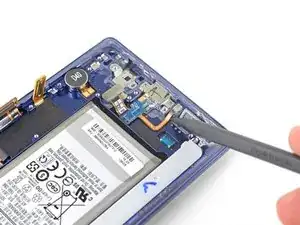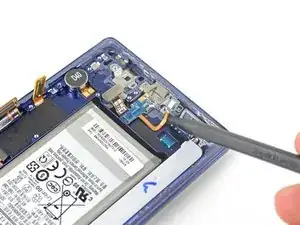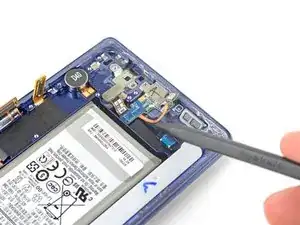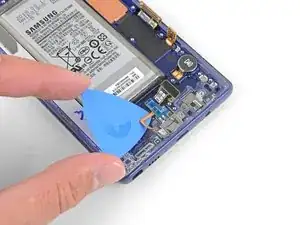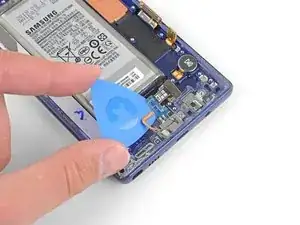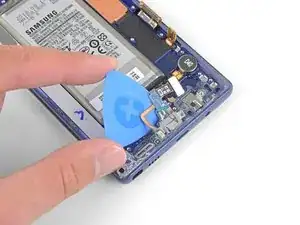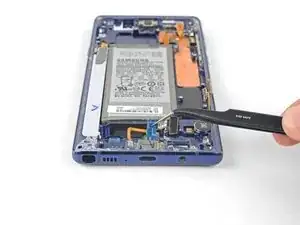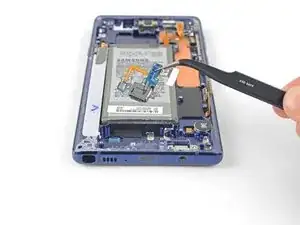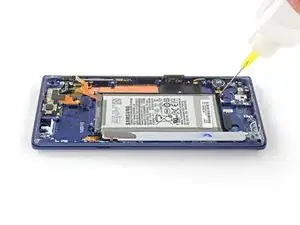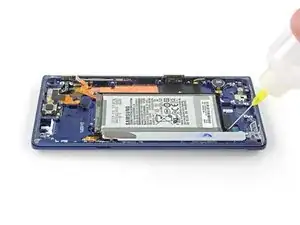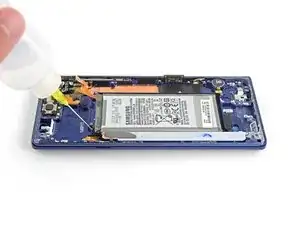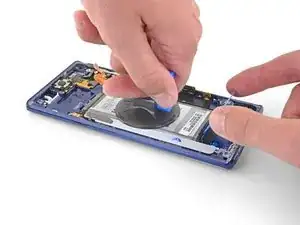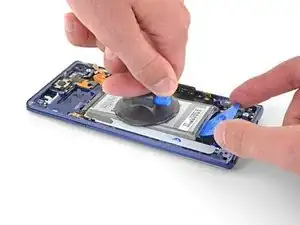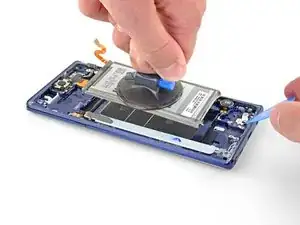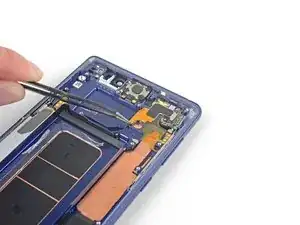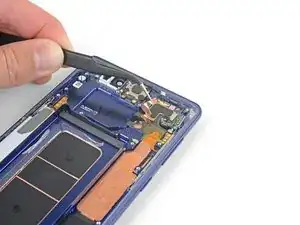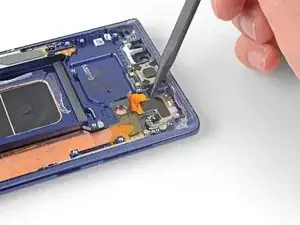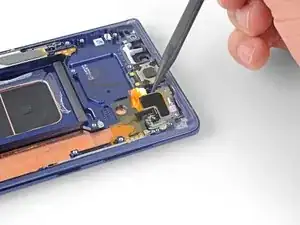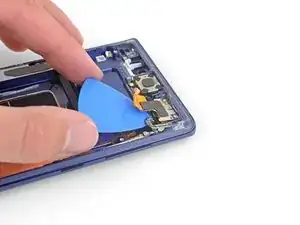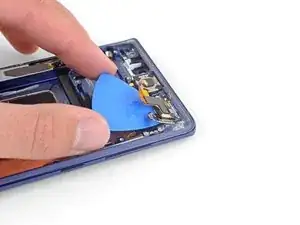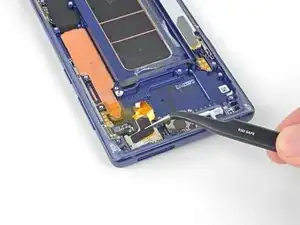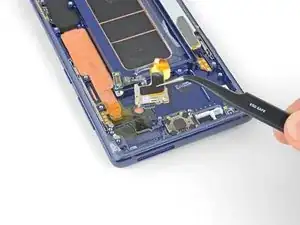Introduction
Follow this guide to replace the display assembly on your Samsung Galaxy Note9.
Tools
Parts
-
-
Press in the bottom of the S-Pen until it clicks.
-
Release the S-Pen and it will self-eject.
-
Remove the S-Pen.
-
-
-
Insert a SIM card eject tool straight into the hole in the SIM card tray.
-
Press to eject the SIM card tray.
-
-
-
Power off your phone before beginning disassembly.
-
Use a hairdryer, a heatgun, or prepare an iOpener and apply it to the right edge of the back of the phone for about a minute to soften the adhesive underneath.
-
-
-
Apply a suction handle to the back cover.
-
Lift with a suction handle to create a gap between the back cover and the frame of the phone.
-
Insert an opening pick into the gap.
-
-
-
Note that there is more adhesive along the top edge and around the camera bezel than around the rest of the phone.
-
Cut carefully around the left edge near the fingerprint sensor or you risk damaging the ribbon cable inside.
-
-
-
Leave an opening pick in the upper-right corner.
-
Use another opening pick to cut the adhesive around the bottom-right corner.
-
Leave that opening pick in the phone.
-
-
-
Use a heat gun or hair dryer or apply a heated iOpener to the left side of the rear panel for at three minutes to soften the adhesive underneath.
-
-
-
Insert an opening pick into the lower-left corner of the rear panel.
-
Using another opening pick, cut the adhesive along the left edge of the rear panel.
-
-
-
Using the inserted opening pick, carefully cut the adhesive around the upper-left corner of the rear panel.
-
Finally, cut the last of the adhesive along the top of the phone.
-
-
-
Separate the right side of the rear cover first.
-
Tilt the cover up along the left edge to expose the fingerprint sensor ribbon cable.
-
-
-
Use the tip of a spudger to pry the fingerprint sensor ribbon cable up and out of its socket.
-
-
-
Remove the back cover.
-
Use tweezers to peel away any remaining adhesive from the phone's chassis. Then clean the adhesion areas with high concentration isopropyl alcohol (at least 90%) and a lint-free cloth to prep the surface for the new adhesive. You don't have to clear out adhesive down to the plastic but larger pieces should be removed.
-
Turn on your phone and test your repair before installing new adhesive and resealing the phone.
-
Carefully apply the new adhesive to the back cover, then line up one edge of the glass against the phone chassis and firmly press the glass into the phone.
-
-
-
Insert the tip of a spudger into the upper-left corner of the upper midframe.
-
Pry the upper midframe out of the phone.
-
-
-
Use the tip of a spudger to disconnect the orange ribbon cable connecting the battery to the motherboard.
-
-
-
Insert the tip of a spudger into the top of the lower midframe.
-
Pry the lower midframe out from the phone.
-
Remove the lower midframe.
-
-
-
Use the tip of a spudger to pry the front camera connector straight up and out of its socket.
-
Use tweezers to remove the front camera.
-
-
-
Use the tip of a spudger to disconnect the iris scanner from the motherboard.
-
Use tweezers to remove the iris scanner.
-
-
-
Use a spudger to gently lift the motherbord from the upper-left corner.
-
Carefully remove the motherboard.
-
-
-
Insert the tip of a spudger into the notch next to the headphone jack contact points.
-
Pry the contact board straight up to free it from the adhesive underneath.
-
-
-
Apply a few drops of 90% isopropyl alcohol into the battery well along the bottom and upper-left corner of the battery.
-
Wait a couple of minutes for the alcohol to soften the adhesive under the battery.
-
Hold the phone at various angles to help the alcohol flow under the battery.
-
-
-
Apply a suction cup to the battery.
-
Lift the battery straight up until there is a gap large enough to insert the opening pick.
-
Insert an opening pick underneath the bottom edge of the battery and twist to loosen the battery adhesive.
-
Remove the battery.
-
-
-
Use a pair of tweezers to peel back the adhesive-backed copper foil.
-
Stop peeling once you reach the sensor array.
-
-
-
Use a spudger to lift the left side of the front sensor array and separate the adhesive the rest of the way.
-
-
-
Carefully slide an opening pick under the front sensor array ribbon cable to cut the adhesive underneath.
-
To reassemble your device, follow the above steps in reverse order.
Take your e-waste to an R2 or e-Stewards certified recycler.
Repair didn’t go as planned? Check out our Answers community for troubleshooting help.
Compare your new replacement part to the original part—you may need to transfer remaining components or remove adhesive backings from the new part before installing.
15 comments
Make sure you transfer over the vibration motor if the new frame does not have it… didn’t realize my replacement didn’t have it until I put the glass back on :/
Thank you for pointing this out! I almost missed it! I wish this guide showed how to put it back together instead of just saying “okay now do it again but backwards.” Anyway, I appreciate this comment right here haha.
Is it just me or is this guide not complete?
The guide assumes that you have a new display unit containing all the parts that are left after the last step (display, front glass, screen, cooling system, vibration motor and so on.)
Since replacement parts vary from seller to seller, you’ll have to compare yours to the original and transfer any remaining components. This guide was written for the display assembly that we were selling at the time.
When transferring other components such as the vibration motor just be sure to use the same methods as with similar components. Work slowly, always use heat or ≥90% isopropyl alcohol to soften adhesives, and search the internet for more information as necessary.
But what about the actual replacement of the display screen? The instructions stops at removing the front sensor array
Because it is an OLED screen the entire assembly has to be replaced. If the guide is followed and the part was purchased from iFixit, once the front sensor array is removed you can begin working backwards transferring all components into the new display assembly. Unfortunately replacing the screen from the front is not possible. If you purchase the part from somewhere other than iFixit you may need to transfer additional components.

